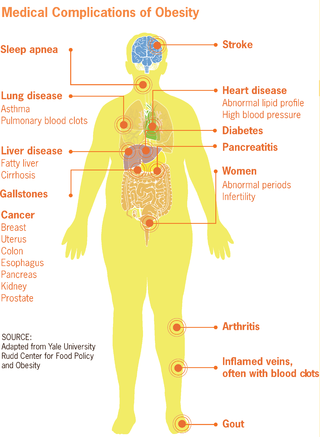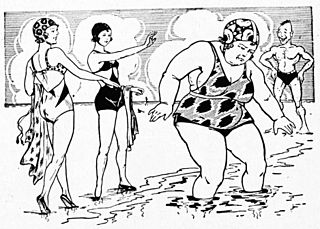
Body mass index (BMI) is a value derived from the mass (weight) and height of a person. The BMI is defined as the body mass divided by the square of the body height, and is expressed in units of kg/m2, resulting from mass in kilograms and height in metres.

The fat acceptance movement is a social movement which seeks to eliminate the social stigma of obesity from social attitudes by pointing out the obstacles which are faced by fat people to those who are less fat. Areas of contention include the aesthetic, legal, and medical approaches to fat people.

Obesity is a medical condition, sometimes considered a disease, in which excess body fat has accumulated to such an extent that it negatively affects health. People are classified as obese when their body mass index (BMI)—a person's weight divided by the square of the person's height—is over 30 kg/m2; the range 25–30 kg/m2 is defined as overweight. Some East Asian countries use lower values to calculate obesity. Obesity is a major cause of disability and is correlated with various diseases and conditions, particularly cardiovascular diseases, type 2 diabetes, obstructive sleep apnea, certain types of cancer, and osteoarthritis.

Body image is a person's thoughts, feelings and perception of the aesthetics or sexual attractiveness of their own body. The concept of body image is used in a number of disciplines, including neuroscience, psychology, medicine, psychiatry, psychoanalysis, philosophy, cultural and feminist studies; the media also often uses the term. Across these disciplines, there is no single consensus definition, but broadly speaking body image consists of the ways people view themselves; their memories, experiences, assumptions, and comparisons about their own appearances; and their overall attitudes towards their own respective heights, shapes, and weights—all of which are shaped by prevalent social and cultural ideals.
Fat fetishism or adipophilia is a sexual attraction directed towards overweight or obese people due primarily to their weight and size.

Childhood obesity is a condition where excess body fat negatively affects a child's health or well-being. As methods to determine body fat directly are difficult, the diagnosis of obesity is often based on BMI. Due to the rising prevalence of obesity in children and its many adverse health effects it is being recognized as a serious public health concern. The term 'overweight' rather than 'obese' is often used when discussing childhood obesity, as it is less stigmatizing, although the term 'overweight' can also refer to a different BMI category. The prevalence of childhood obesity is known to differ by sex and gender.

"Big Beautiful Woman" is a euphemism for an overweight woman.
Health at Every Size (HAES) is an approach to public health that seeks to downplay weight loss as a health goal, and reduce stigma towards people who are overweight or obese. Proponents argue that traditional interventions focused on weight loss, such as dieting, do not reliably produce positive health outcomes, and that health is a result of lifestyle behaviors that can be performed independently of body weight. However, many criticize the approach and argue that weight loss should sometimes be an explicit goal of healthcare interventions, because of the negative health outcomes associated with obesity.

Fat feminism, often associated with "body-positivity", is a social movement that incorporates feminist themes of equality, social justice, and cultural analysis based on the weight of a woman or a non-binary feminine person. This branch of feminism intersects misogyny and sexism with anti-fat bias. Fat feminists advocate body-positive acceptance for all bodies, regardless of their weight, as well as eliminating biases experienced directly or indirectly by fat people. Fat feminists originated during third-wave feminism and is aligned with the fat acceptance movement. A significant portion of body positivity in the third-wave focused on embracing and reclaiming femininity, such as wearing makeup and high heels, even though the second-wave fought against these things. Contemporary western fat feminism works to dismantle oppressive power structures which disproportionately affect fat, queer, non-white, disabled, and other non-hegemonic bodies. It covers a wide range of topics such as diet culture, fat-phobia, representation in media, ableism, and employment discrimination.
Sizeism or size discrimination is unjust or prejudicial treatment directed at people based on their size.
The obesity paradox is the finding in some studies of a lower mortality rate for overweight or obese people within certain subpopulations. The paradox has been observed in people with cardiovascular disease and cancer. Explanations for the paradox range from excess weight being protective to the statistical association being caused by methodological flaws such as confounding, detection bias, reverse causality, or selection bias.

Obesity is a risk factor for many chronic physical and mental illnesses.
Social stigma of obesity is broadly defined as bias or discriminatory behaviors targeted at overweight and obese individuals because of their weight and a high body fat percentage. Such social stigmas can span one's entire life, as long as excess weight is present, starting from a young age and lasting into adulthood. Studies also indicate overweight and obese individuals experience higher levels of stigma compared to other people.
The thin ideal is the concept of the ideally slim female body. The common perception of this ideal is a woman who possesses a slender, feminine physique with a small waist and little body fat. The size that the thin ideal woman should be is decreasing while the rate of female obesity is simultaneously increasing, making this iconic body difficult for women to maintain. This creates a gap between the actual appearance of an average woman’s body and its expected appearance which, depending on the extent to which a woman internalizes the necessity of living up to this ideal for her well-being and peace of mind, may have serious psychological effects.
Body shape refers to the many physical attributes of the human body that make up its appearance, including size and countenance. Body shape has come to imply not only sexual/reproductive ability, but wellness and fitness. In the West, slenderness is associated with happiness, success, youth, and social acceptability. Being overweight is associated with laziness. The media promote a weight-conscious standard for women more often than for men. Deviance from these norms result in social consequences. The media perpetuate this ideal in various ways, particularly glorifying and focusing on thin actors and actresses, models, and other public figures while avoiding the use or image of overweight individuals. This thin ideal represents less than 5% of the American population.

Obesity and the environment aims to look at the different environmental factors that researchers worldwide have determined cause and perpetuate obesity. Obesity is a condition in which a person's weight is higher than what is considered healthy for their height, and is the leading cause of preventable death worldwide. Obesity can result from several factors such as poor nutritional choices, overeating, genetics, culture, and metabolism. Many diseases and health complications are associated with obesity. Worldwide, the rates of obesity have nearly tripled since 1975, leading health professionals to label the condition as a modern epidemic in most parts of the world. Current worldwide population estimates of obese adults are near 13%; overweight adults total approximately 39%.

Body shaming is the action or inaction of subjecting someone to humiliation and criticism for their bodily features. The scope of body shaming is wide, and includes, although is not limited to fat-shaming, shaming for thinness, height-shaming, shaming of hairiness, of hair-color, body-shape, one's muscularity, shaming of penis size or breast size, shaming of looks, and in its broadest sense may even include shaming of tattoos and piercings or diseases that leave a physical mark such as psoriasis.
Obesity is defined as an abnormal accumulation of body fat, usually 20% or more over an individual's ideal body weight. This is often described as a body mass index (BMI) over 30. However, BMI does not account for whether the excess weight is fat or muscle, and is not a measure of body composition. For most people, however, BMI is an indication used worldwide to estimate nutritional status. Obesity is usually the result of consuming more calories than the body needs and not expending that energy by doing exercise. There are genetic causes and hormonal disorders that cause people to gain significant amounts of weight but this is rare. People in the obese category are much more likely to suffer from fertility problems than people of normal healthy weight.
An anti-fatphobia organization is an organization that works to address the social stigma of obesity. Anti-fatphobia organizations typically define themselves by their desire to end fatphobia in whichever contexts they focus on. Anti-fatphobia organizations in the United States are closely tied to the fat acceptance movement with anti-fatphobia activism in general, which begun around the 1960s. The fat acceptance movement can be described as a movement which centres fat people in order to address the oppression they face in society for being fat. The fat acceptance movement calls for societal recognition of a need for systemic change. Anti-fatphobia organizations often take an intersectional approach, and address how fatness is experienced at varying intersections of identity. In the United States, there are two main anti-fatphobia organizations. These organizations are NOLOSE, or the National Organization of Lesbians of Every Size, and NAAFA, or the National Association to Advance Fat Acceptance.

Being overweight or obese has influence on the sexuality of people in various different aspects. It can include negative aspects such as stigmatization which can be an obstacle for romantic developments, sexual dysfunction and an increased chance of risky sexual behavior. It can also have positive aspects in the form of fat fetishism.









